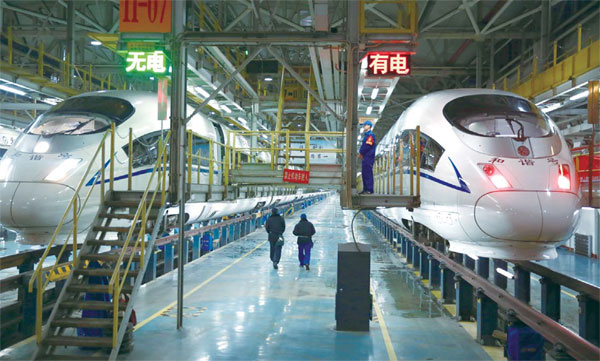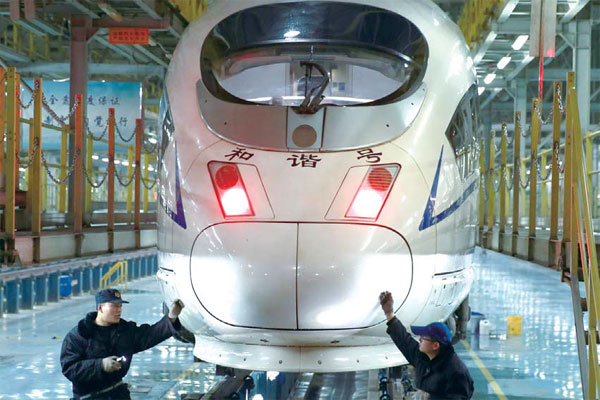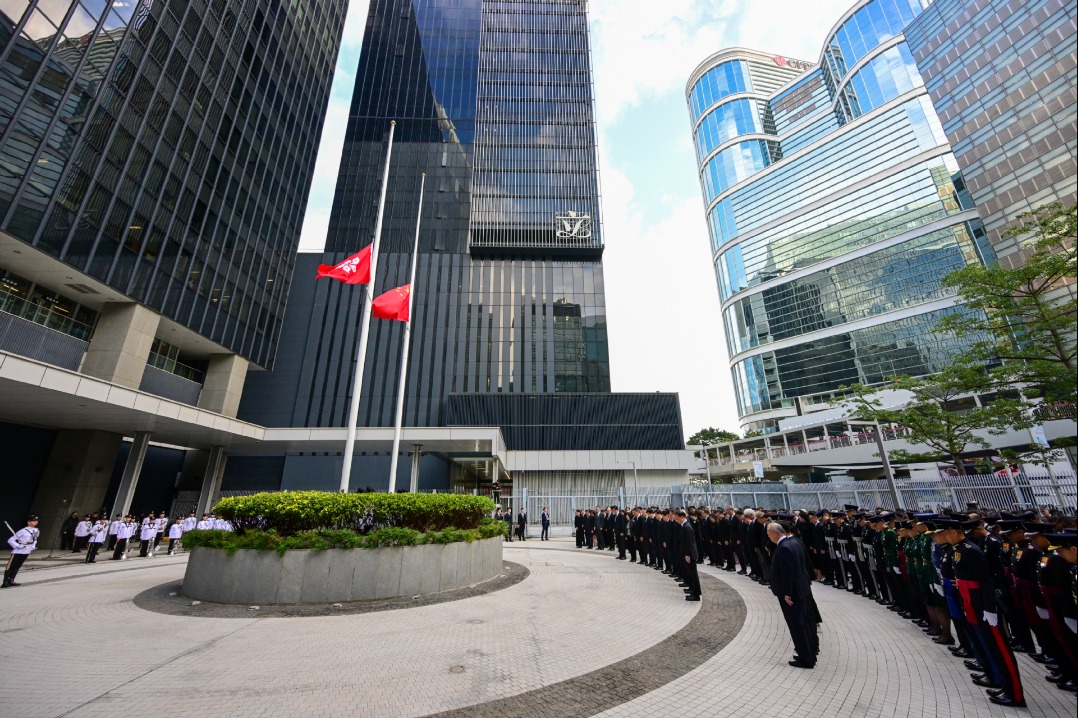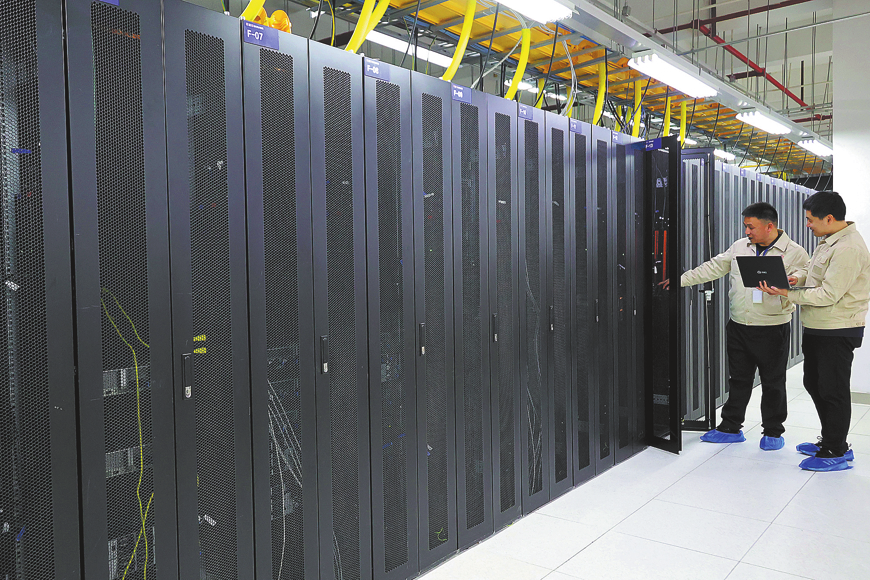Rail firms on track to haul the world

Chinese companies gear up to export bullet trains, rail technology and equipment, and subway cars
China Railway Rolling Stock Corp, the country's largest train-maker, plans to build bullet trains and provide other services in developed markets, including the United States and the United Kingdom, over the next five years to compete with established rivals in Europe, Japan and Canada.
Many opportunities come from the surging demand in these countries for improved railway infrastructure, passenger services and regional connectivity, as well as their desire to create jobs and new commercial areas.
| Bullet trains at a factory of CRRC Qingdao Sifang Co Ltd in Qingdao, Shandong province. CSR Sifang America JV, a CRRC subsidiary, has clinched a $1.3 billion deal with the Chicago Transit Authority to supply up to 846 metro vehicles to the Midwestern city. Photos provided to China Daily |
| Technicians examine a nearly finished bullet train at the factory. |
CRRC has set a target of 30 percent growth by 2020 in its research and development ability from current levels. This is especially applicable to its three bullet train subsidiaries: CRRC Tangshan Co Ltd, CRRC Qingdao Sifang Co Ltd and CRRC Changchun Co Ltd.
Yu Weiping, vice-president of CRRC, says the company is also developing "smart trains", which will use advanced technologies that enable automatic controls of speed and interior conditions, and fault detection.
The goal is to grab a bigger share of the global market from foreign competitors, he says, adding that the company is in talks with more than 30 countries about high-speed rail projects, including the US, Russia, Brazil, Thailand, Turkey, Saudi Arabia and Iran.
CRRC and its partner, China Railway Corp, the railway service provider, were selected by the Indonesian government last year to build the nation's first bullet train link. The two companies will construct a $5.5 billion line stretching 150 kilometers from the capital, Jakarta, to Bandung.
It will be China's first overseas high-speed train project and involves design and construction work, financing solutions, and operational and maintenance services.
With more than 184,000 employees and 52 subsidiaries covering industries such as signal system design and train equipment production, CRRC has already built manufacturing facilities and maintenance centers in the US, Malaysia, Turkey and Brazil.
Yu says the company is keen to contribute to a new high-speed rail culture in the US.
"With high-speed trains traveling at speeds of more than 300 km/h, it will help the US to change its ground commuting systems, which have long been dominated by automobiles," he says.
Even though China is a latecomer compared with its German and French rivals, Yu says the country's rail equipment companies have thrived thanks to cost advantages, reasonable delivery times and flexible financing models.
The Chinese government announced in September that a 370-km, high-speed railway project between Las Vegas and Los Angeles will be built by a joint venture involving China Railway Construction Corp, China Railway Corp and XpressWest Enterprises, a US passenger rail service provider.
The construction work between Nevada and California is expected to start in September, and the estimated investment is $12.7 billion.
Wang Yongzhi, chief information officer at CRRC, says the Belt and Road Initiative will also help China export more high-speed rail technologies to a number of lucrative markets during the 13th Five-Year Plan, the nation's development blueprint for 2016 to 2020.
The trade and infrastructure network, proposed by China in 2013, envisions a Silk Road Economic Belt and a 21st Century Maritime Silk Road, covering about 4.4 billion people in more than 60 countries and regions in Asia, Europe and Africa.
CRRC is also preparing to export bullet trains for a high-speed rail project in Russia that would connect Moscow to Kazan. The length of the line is expected to be about 770 km and will run through seven Russian regions with a total population of more than 25 million.
"As most countries along the initiative (routes) - especially in Central Asia, Southeast Asia, the Middle East and Eastern Europe - are planning to build high-speed rail lines or upgrade their existing railway systems, they are willing to acquire technological support from China to assist in the daily operations, maintenance, staff training and other services," Wang says.
CSR Sifang America, a CRRC subsidiary, has also secured a $1.3 billion deal with the Chicago Transit Authority to supply up to 846 metro vehicles to the city. This is the biggest railcar purchase in the agency's history.
Another CRRC subsidiary is currently building trains in Massachusetts after sealing a deal with the Massachusetts Bay Transportation Authority to supply 284 railcars to the Boston transit system.
"This deal represents another major breakthrough for the Chinese railway vehicles in the North American market," says Wang Mengshu, an academician at the Chinese Academy of Engineering.
He says it certainly will rouse the interest of more countries, which are keen to put their economic growth on a firmer footing through efficient transportation systems and regional connectivity.
Under the deal, the 7000 series railcars will be assembled at a purpose-built plant in Chicago, to replace the 2600 series manufactured in the 1980s.
The Chicago Transit Authority started procurement for the 7000 series deal in 2013, but the bidding gained little interest and a revised tender was launched in 2014.
CRRC made a $1.3 billion offer for 846 railcars, about $226 million lower than the bid by Canadian rival Bombardier Inc. Its $632 million base order comprises 400 cars with options for a further 446 vehicles.
The Chicago authority says the purchase will give the city one of the youngest rail fleets in the US, with the average age of a railcar dropping from 26 years in 2011 to 13 years once all the railcars are delivered, as well as saving $7 million a year in maintenance.
zhongnan@chinadaily.com.cn
(China Daily European Weekly 04/01/2016 page28)
Today's Top News
- Takaichi must stop rubbing salt in wounds, retract Taiwan remarks
- Millions vie for civil service jobs
- Chinese landmark trade corridor handles over 5m TEUs
- China holds first national civil service exam since raising eligibility age cap
- Xi's article on CPC self-reform to be published
- Xi stresses improving long-term mechanisms for cyberspace governance
































